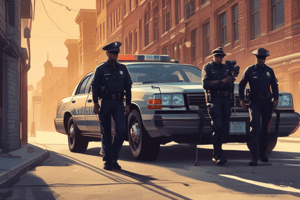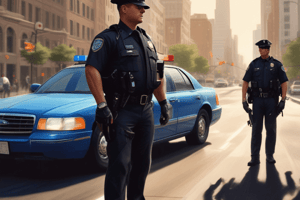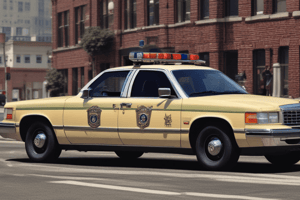Podcast
Questions and Answers
What is the primary purpose of the patrol book exchange between Patrolmen?
What is the primary purpose of the patrol book exchange between Patrolmen?
- To convey information from one station to the other and back again (correct)
- To monitor the patrolman's movement
- To report the absence of any Patrolman from his beat
- To ensure the patrolman is sober and fully equipped
What should a Patrolman do if the next Patrolman is not available to take over the patrol book?
What should a Patrolman do if the next Patrolman is not available to take over the patrol book?
- Report the absence to the Station Master
- Proceed ahead until he meets the next Patrolman (correct)
- Return to the original station
- Wait at the end of the beat for the next Patrolman
What is the responsibility of the Station Master in relation to the Patrolmen?
What is the responsibility of the Station Master in relation to the Patrolmen?
- To monitor the patrolman's movement
- To ensure the Patrolmen come on duty sober and fully equipped (correct)
- To ensure the patrolman is provided with a GPS tracking device
- To advise the other Station Master of the Patrolman's absence
What should the Station Master/Block hut-in-charge do if a Patrolman does not turn up in time?
What should the Station Master/Block hut-in-charge do if a Patrolman does not turn up in time?
What is the purpose of the GPS tracking device for the Patrolman?
What is the purpose of the GPS tracking device for the Patrolman?
What should the Patrolman do if he finds the next Patrolman is absent from his beat?
What should the Patrolman do if he finds the next Patrolman is absent from his beat?
Why may patrol books be passed through one or more intermediate stations?
Why may patrol books be passed through one or more intermediate stations?
What should the Station Master/Block hut-in-charge do if a Patrolman is due to arrive at a station but does not turn up?
What should the Station Master/Block hut-in-charge do if a Patrolman is due to arrive at a station but does not turn up?
In regions where there is a high risk of danger, how many patrolling officers are approved to patrol together?
In regions where there is a high risk of danger, how many patrolling officers are approved to patrol together?
What is the maximum length of each patrol beat normally?
What is the maximum length of each patrol beat normally?
What is the walking speed of a Patrolman?
What is the walking speed of a Patrolman?
What is the maximum distance a Patrolman should cover in a day?
What is the maximum distance a Patrolman should cover in a day?
What is the minimum rest period required between consecutive beats?
What is the minimum rest period required between consecutive beats?
Why is it advantageous to plot the scheduled paths of all passenger trains?
Why is it advantageous to plot the scheduled paths of all passenger trains?
What type of locations should be shown on patrol charts?
What type of locations should be shown on patrol charts?
What is appended for guidance in Annexure - 10/1, 10/2, 10/3?
What is appended for guidance in Annexure - 10/1, 10/2, 10/3?
What is the procedure when a portion of the line is breached or rendered unsafe for traffic?
What is the procedure when a portion of the line is breached or rendered unsafe for traffic?
Who is responsible for submitting a certificate to the DEN through ADEN?
Who is responsible for submitting a certificate to the DEN through ADEN?
What is the purpose of the certificate submitted by the SSE/P.Way (In-charge)?
What is the purpose of the certificate submitted by the SSE/P.Way (In-charge)?
What should the patrolmen do when they are 600 m from the point of danger?
What should the patrolmen do when they are 600 m from the point of danger?
What is the distance from the point of danger where the patrolmen should place three detonators on the rail?
What is the distance from the point of danger where the patrolmen should place three detonators on the rail?
What is the first step taken when damage is detected on a single line?
What is the first step taken when damage is detected on a single line?
Why are the patrolmen required to undergo a medical test?
Why are the patrolmen required to undergo a medical test?
Who is responsible for selecting the track maintainers to be sent for a vision test?
Who is responsible for selecting the track maintainers to be sent for a vision test?
How many detonators are placed at 10 metres apart at 1200 m from the site of obstruction/damage?
How many detonators are placed at 10 metres apart at 1200 m from the site of obstruction/damage?
What is the purpose of the patrolmen and watchmen being made conversant with their duties?
What is the purpose of the patrolmen and watchmen being made conversant with their duties?
What is done if it is impossible to get to the other side of the obstruction/damage?
What is done if it is impossible to get to the other side of the obstruction/damage?
On a double line, where is the red flag/lamp placed initially?
On a double line, where is the red flag/lamp placed initially?
What is done after placing the detonators on the other track on a double line?
What is done after placing the detonators on the other track on a double line?
When is a red light used in place of a red flag?
When is a red light used in place of a red flag?
What is the purpose of placing a red lamp/flag in a prominent position?
What is the purpose of placing a red lamp/flag in a prominent position?
Why do you run in the opposite direction from which train is likely to come?
Why do you run in the opposite direction from which train is likely to come?
How often should JE/SSE/P.Way (Sectional) inspect night patrolling by train?
How often should JE/SSE/P.Way (Sectional) inspect night patrolling by train?
What is the frequency of ADEN's night patrolling by train?
What is the frequency of ADEN's night patrolling by train?
What action should ADEN and JE/SSE/P.Way take on receiving information about damage to the line?
What action should ADEN and JE/SSE/P.Way take on receiving information about damage to the line?
Who prepares the patrol charts for hot weather patrolling?
Who prepares the patrol charts for hot weather patrolling?
At what rail temperature should hot weather patrolling be introduced on PSC sleeper tracks with sleeper density 1540 nos./km and above?
At what rail temperature should hot weather patrolling be introduced on PSC sleeper tracks with sleeper density 1540 nos./km and above?
What is the patrol beat for hot weather patrolling on single lines or sections with only one road?
What is the patrol beat for hot weather patrolling on single lines or sections with only one road?
Who should be vigilant during summer and on hot days?
Who should be vigilant during summer and on hot days?
On what type of tracks should hot weather patrolling be introduced at a rail temperature of td + 20° C?
On what type of tracks should hot weather patrolling be introduced at a rail temperature of td + 20° C?
Flashcards are hidden until you start studying
Study Notes
Patrol Charts and Patrolling Principles
- Ordinarily, patrolling will be carried out by a single Patrolman, but in regions with high risk, patrolling in pairs may be introduced with the approval of Sr DEN Co.
- All trains carrying passengers between sunset and sunrise get the maximum protection possible.
- Each block section will be treated as a unit and divided into equal beats, with each patrol beat not normally exceeding 5 km.
- The walking speed of a Patrolman is taken as 3 kmph.
- The maximum distance covered by a Patrolman should not normally exceed 20 km in a day.
- A period of at least half an hour rest is desirable between consecutive beats.
- Patrol charts should show all vulnerable locations where stationary watchmen are posted.
Patrol Movement and Rest
- Patrolmen should patrol their length and exchange their patrol book with the next Patrolman, then retrace their beat.
- Intermediate patrolmen shall do likewise, conveying patrol books from one station to another and back again.
Station Masters' Responsibilities
- Station Masters will ensure Patrolmen come on duty sober and fully equipped, with trimmed and filled lamps or fully charged batteries.
- Station Masters will advise Station Master/Block hut-in-charge at the other end of the block section about the absence of a Patrolman.
Patrolmen and Equipment
- Patrolmen should be provided with GPS tracking devices to monitor their movements and ensure effective patrolling.
- Track maintainers selected from each gang will be sent for vision tests and will not be employed as patrolmen unless they have passed the requisite medical test.
SSE/P.Way (In-charge) Certificate and Monsoon Patrolling
- The SSE/P.Way (In-charge) shall submit a certificate to the DEN through ADEN, a month in advance before the commencement of the monsoon, stating arrangements for monsoon patrolling and watching vulnerable locations.
- The SSE/P.Way (In-charge) will submit a list of patrolmen and watchmen with their duties and locations assigned during the patrolling season.
Action When Damage is Observed
- In the event of any portion of the line being breached or otherwise rendered unsafe for traffic, the following procedure shall be observed:
- Two patrolmen employed: Protect the line, exhibit danger signals, and place detonators.
- One patrolman employed: Protect the line, place a red lamp or flag, and run in the opposite direction to place detonators.
Check over Patrolling at Nights
- JE/SSE/P.Way and SSE/P.Way (In-charge) will conduct inspections of night patrolling by train according to a schedule.
- ADEN will cover his entire sub-division once a month by train in the night and check patrolmen.
Action by ADEN and JE/SSE/P.Way on Receipt of Information Regarding Damage to the Line
- On receipt of information of any damage to the line, ADEN, JE/SSE/P.Way, and SSE/P.Way (In-charge) will proceed to the site and take necessary action for restoration.
Hot and Cold Weather Patrolling for LWR/CWR
- Period for hot weather patrolling will be laid down by the Chief Track Engineer for each section, and patrol charts prepared where necessary.
- JE/SSE/P.Way will organize patrolling accordingly, and be vigilant during summer and on hot days.
- Patrolling will be introduced when the rail temperature rises above specified temperatures.
- Patrol beat for Hot weather patrolling is one patrolman for 2 km on single line or where only one road in a double line section has LWR/CWR.
Studying That Suits You
Use AI to generate personalized quizzes and flashcards to suit your learning preferences.




